- AI Fire
- Posts
- 🧲 How To Build AI Web Apps That Attract Customers Like A Magnet
🧲 How To Build AI Web Apps That Attract Customers Like A Magnet
Learn to build a custom lead magnet web app in minutes using AI. This guide shows you how to use ChatGPT and Claude to get more leads - no coding required.
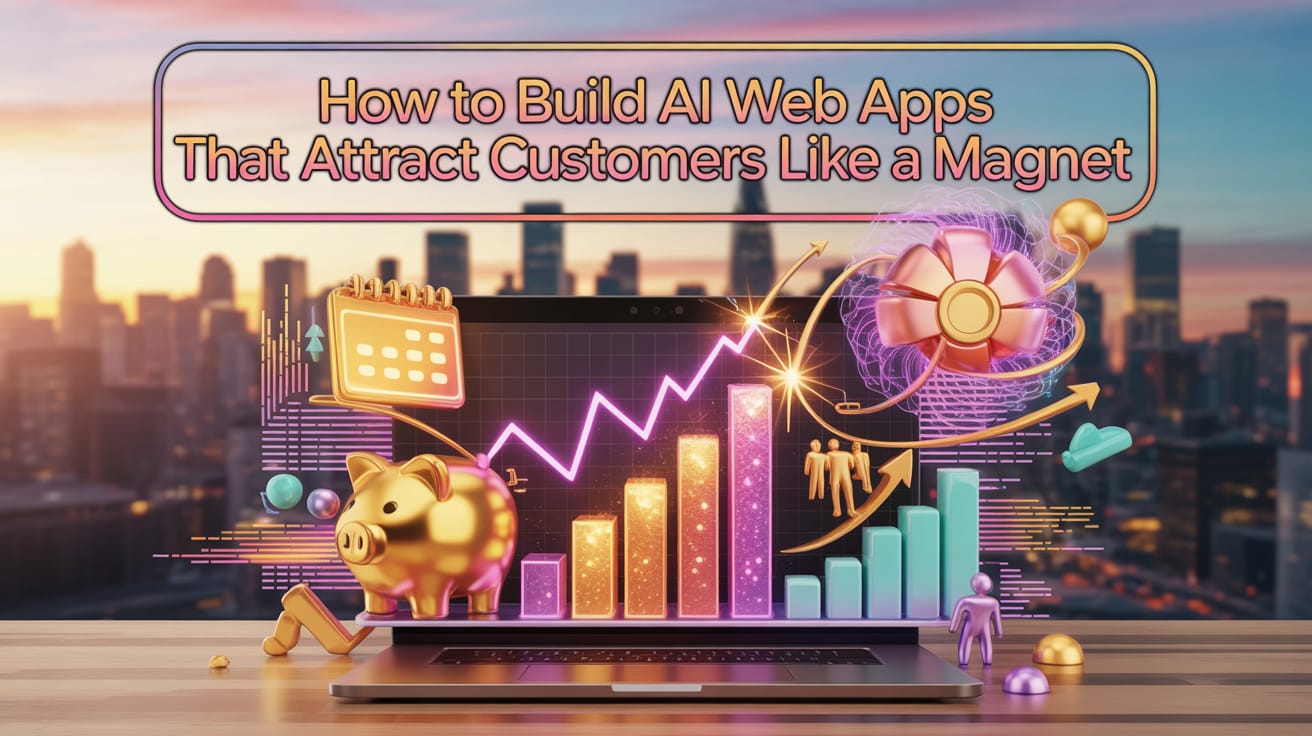
Have you ever tried to create a custom tool or app for your business? |
Table of Contents
Introduction: A New Era Of Digital Marketing
Have you ever dreamed of creating a unique, free tool for your business to attract customers, only to be deterred by the prospect of tens of thousands of dollars in costs and months of waiting? What if I told you that, right now, you can build professional web applications that act as "lead magnets" in under 20 minutes using the power of Artificial Intelligence (AI)?

This isn't a distant future scenario. It's the reality happening right now - a revolution that is completely changing the game for small and medium-sized businesses (SMBs). In this comprehensive guide, we will dive deep into the exact, step-by-step process to turn a simple business idea into a functional web application, ready to collect emails and engage potential customers.
We won't just talk theory. We'll get hands-on with specific examples and detailed prompts that you can customize and apply immediately to any type of business, whether you're a financial consultant, a fitness coach, a restaurant owner, or running any other small enterprise. Get ready to unlock a marketing potential you never thought possible.
Why AI-Generated Lead Magnets Are A Game-Changer
To truly grasp the significance of this approach, let's analyze the revolutionary difference it makes compared to traditional development processes.
The Traditional Development Model (Expensive and Risky):
Massive Costs: Hiring a software development firm to build a simple web app can cost anywhere from $10,000 to $50,000, an almost insurmountable financial barrier for most small businesses.

Long Waiting Times: The process typically takes 2 to 6 months, from ideation, design, coding, testing, and deployment. In a fast-moving business world, this delay can mean missing critical opportunities.

High Risk: You have to invest a large sum of money upfront with no guarantee that your idea will actually work or be well-received by customers.

The AI-Powered Development Model (Fast, Flexible, and Efficient):
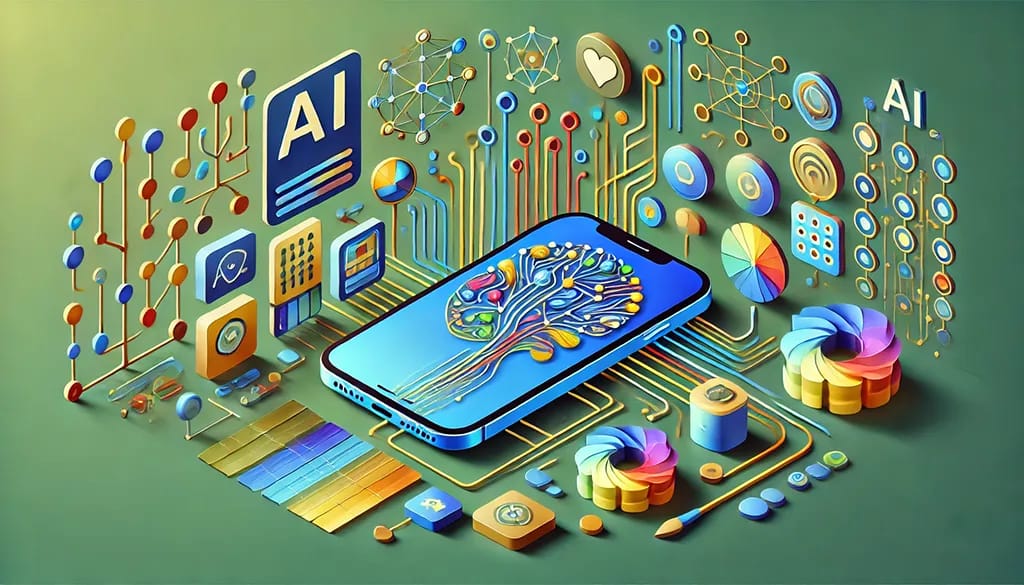
Build in Minutes: Instead of months, you can create Minimum Viable Products (MVPs) in just a few minutes.
Test Ideas at Near-Zero Cost: You can get your application into the hands of real customers to gather feedback before deciding to invest seriously.
Flexible Experimentation: Easily create multiple versions of your app for A/B testing to see which performs best.
No Coding Skills Required: The technical barrier has been removed. Now, the power to create lies in the quality of your ideas, not your ability to write code.
The core advantage here is speed and validation. AI has "democratized" application development, allowing you to fail fast, learn fast, and succeed faster without betting the farm.
Learn How to Make AI Work For You!
Transform your AI skills with the AI Fire Academy Premium Plan - FREE for 14 days! Gain instant access to 500+ AI workflows, advanced tutorials, exclusive case studies and unbeatable discounts. No risks, cancel anytime.
Step 1: Unearthing Golden Ideas With ChatGPT
The first, and most crucial, step isn't to jump straight into coding. It begins with generating truly valuable ideas that solve the pressing problems of your potential customers. This is where we turn to ChatGPT, a boundless engine for creativity.
The Art Of Crafting An Effective Prompt
The quality of the ideas you get from an AI is directly proportional to the quality of the prompt you provide. Instead of a landscaping business, let's consider another case: a personal finance consultant.
Here is an example of a well-crafted prompt:

"I am a personal finance consultant specializing in helping young professionals (ages 25-35) in major cities manage their finances and plan for early retirement. I want to build a free web app to serve as a lead magnet, aimed at attracting clients and collecting their email addresses for deeper consultation. The app needs to solve a specific financial problem that my target audience commonly faces. Please give me 10 innovative web app ideas that are interactive and provide immediate value."Anatomy Of An Effective Prompt:
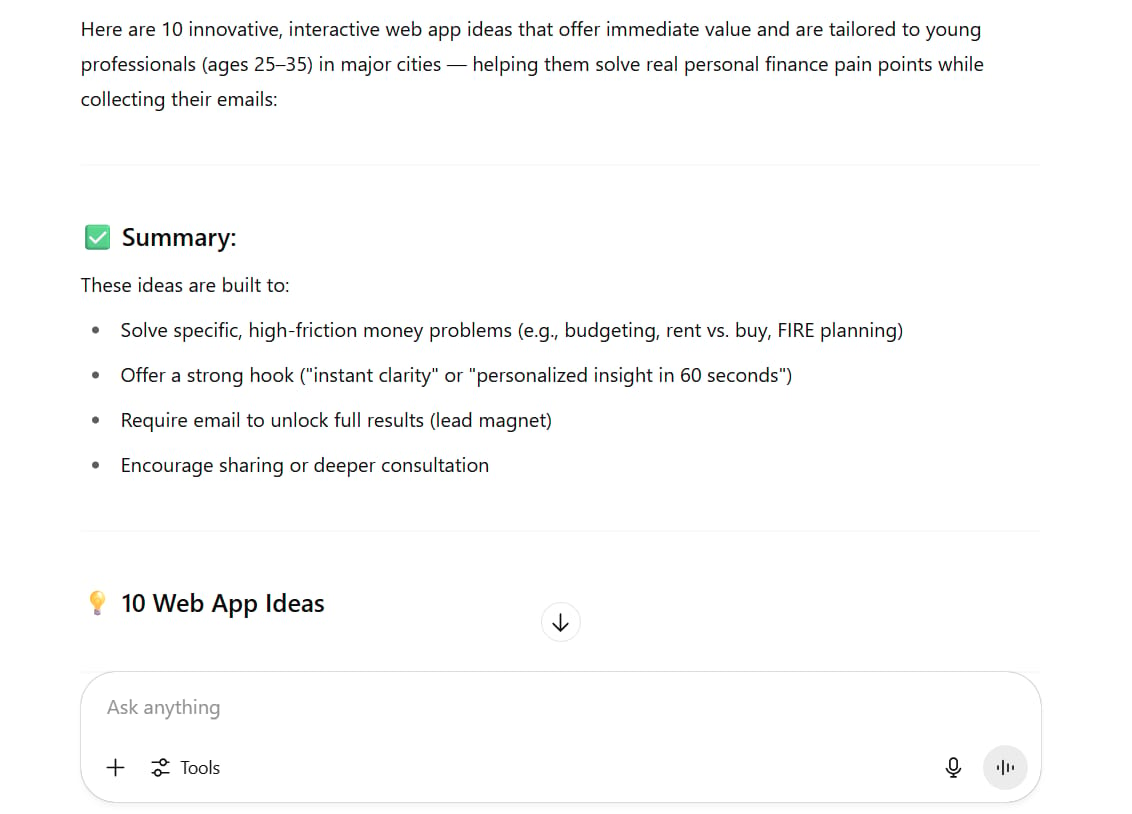
Clear Identity and Audience: "personal finance consultant," "young professionals (ages 25-35)."
Clear Business Goal: "serve as a lead magnet," "attract clients and collect their email addresses."
Problem to Solve: "solve a specific financial problem."
Specific Request: "10 innovative ideas," "focus on interactivity and immediate value."
Potential Ideas From ChatGPT:
Using a detailed prompt like this, ChatGPT might suggest ideas such as:
Financial Independence, Retire Early (FIRE) Calculator: Allows users to input their income, expenses, and savings rate to calculate how many years it will take them to achieve financial independence.

Investment Risk Appetite Quiz: An interactive quiz that helps users determine their risk tolerance and suggests suitable asset allocation strategies (stocks, bonds, etc.).

Retirement Lifestyle Cost Estimator: Based on a desired lifestyle and projected inflation rates, the tool calculates the nest egg needed for a comfortable retirement.

Compound Interest Effect Simulator: A visual tool that demonstrates the power of compound interest over time, encouraging users to start saving and investing early.

"Budget Drain" Analyzer: Users input their monthly expenses, and the app identifies potential "leaks" or wasteful spending that can be cut to boost savings.

Personalized Tax Optimization Calendar: A tool that generates a schedule with key dates and deadlines for implementing tax-saving strategies throughout the year.

IRA vs. 401k Comparison Tool: Helps users understand the pros and cons of different retirement accounts to make the best choice.

"True Value" of a Job Offer Calculator: Goes beyond salary to factor in benefits, commute time, and growth potential to calculate a "total compensation" figure.

Financial Health Scorecard: A comprehensive assessment that grades a user's financial situation across categories like savings, debt, investments, and insurance.

Smart Debt Payoff Planner: Helps users strategize the most effective way to pay off debts (like credit cards or student loans) using the "avalanche" or "snowball" method.

Each of these ideas touches on a specific pain point or question that the target customer is facing, turning them into incredibly compelling lead magnets.
Step 2: Selecting And Detailing Your Idea
Once you have a list of great ideas, choose the 1-2 that you believe have the most potential. In our example, let's focus on the FIRE Calculator and the Financial Health Scorecard.
Now, let's ask ChatGPT to provide a "technical specification" to prepare for the build.
Generating A Build Prompt From ChatGPT
Here’s how you can craft a follow-up prompt:

"Thank you for the fantastic ideas. I've decided to go with idea #1, the Financial Independence Calculator. Please write me a detailed 'one-shot build prompt' that I can copy and paste into an AI coding platform like Claude. I want a basic but fully functional version that I can test immediately. My brand name is 'Wealth Architects'."Why This Prompt Is Important
The phrases "basic version" and "test immediately" are key. You are signaling to the AI that you need an MVP, not a finished product with all the complex features. This helps it focus on the core functionality.
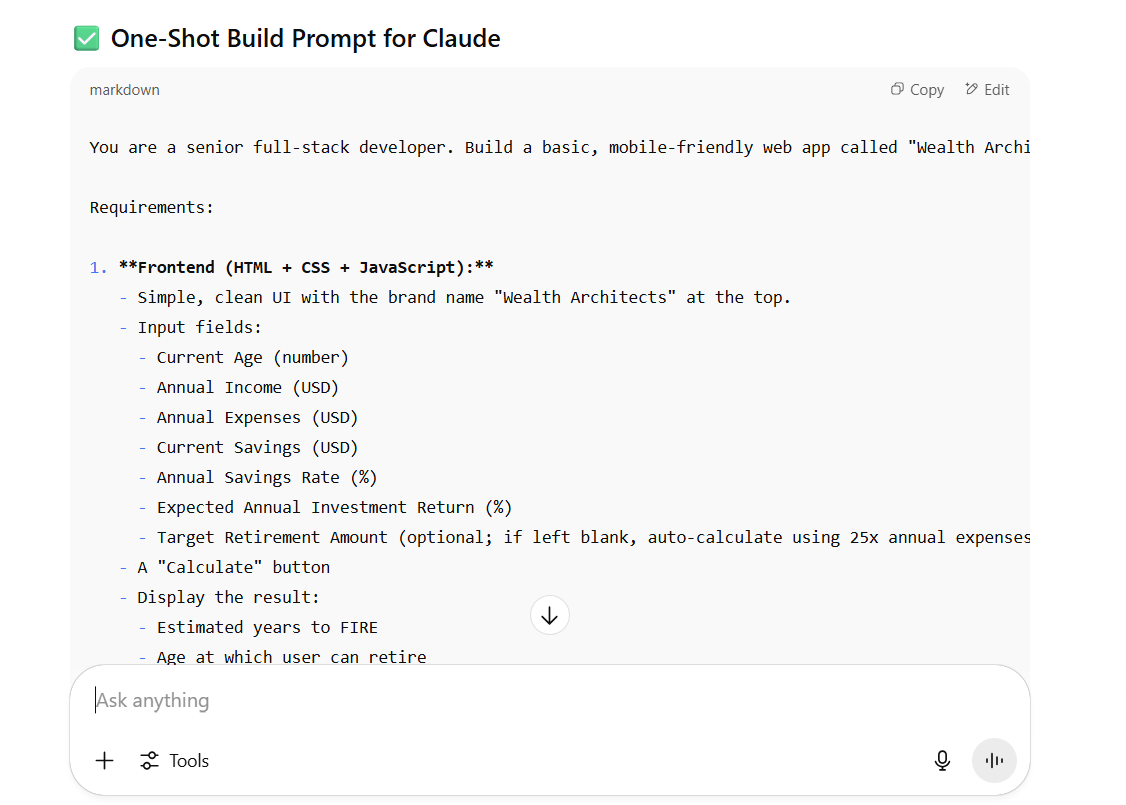
ChatGPT will return an incredibly detailed prompt, describing the user interface (UI), input fields, the calculation logic behind the scenes, and the format of the output. It’s like a detailed blueprint for an architect, but for an AI.
Step 3: Bringing Your App To Life With Claude
This is the magical step where your idea becomes a tangible product. We will use Claude.ai, a powerful AI platform with a unique feature called "Artifacts."
What are Claude Artifacts?
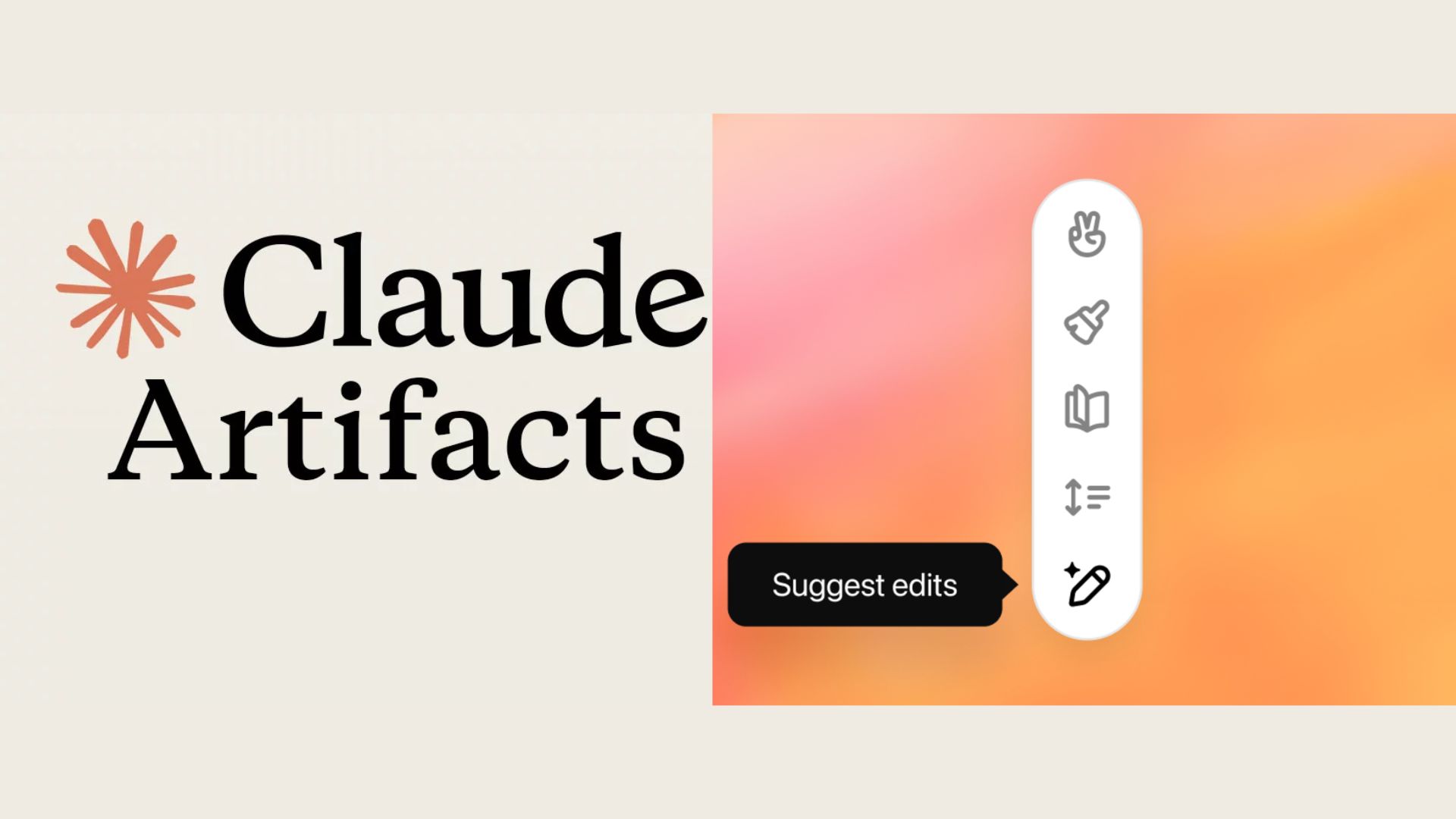
Think of Artifacts as a mini web app factory and showroom. Claude not only writes the code (HTML, CSS, JavaScript) for you but also "hosts" (stores and runs) the application instantly, providing you with a shareable link. You completely bypass the complex technical steps of buying hosting, setting up servers, or managing databases.
The First App Build Process
Go to Claude.ai and look for the "Artifacts" feature.
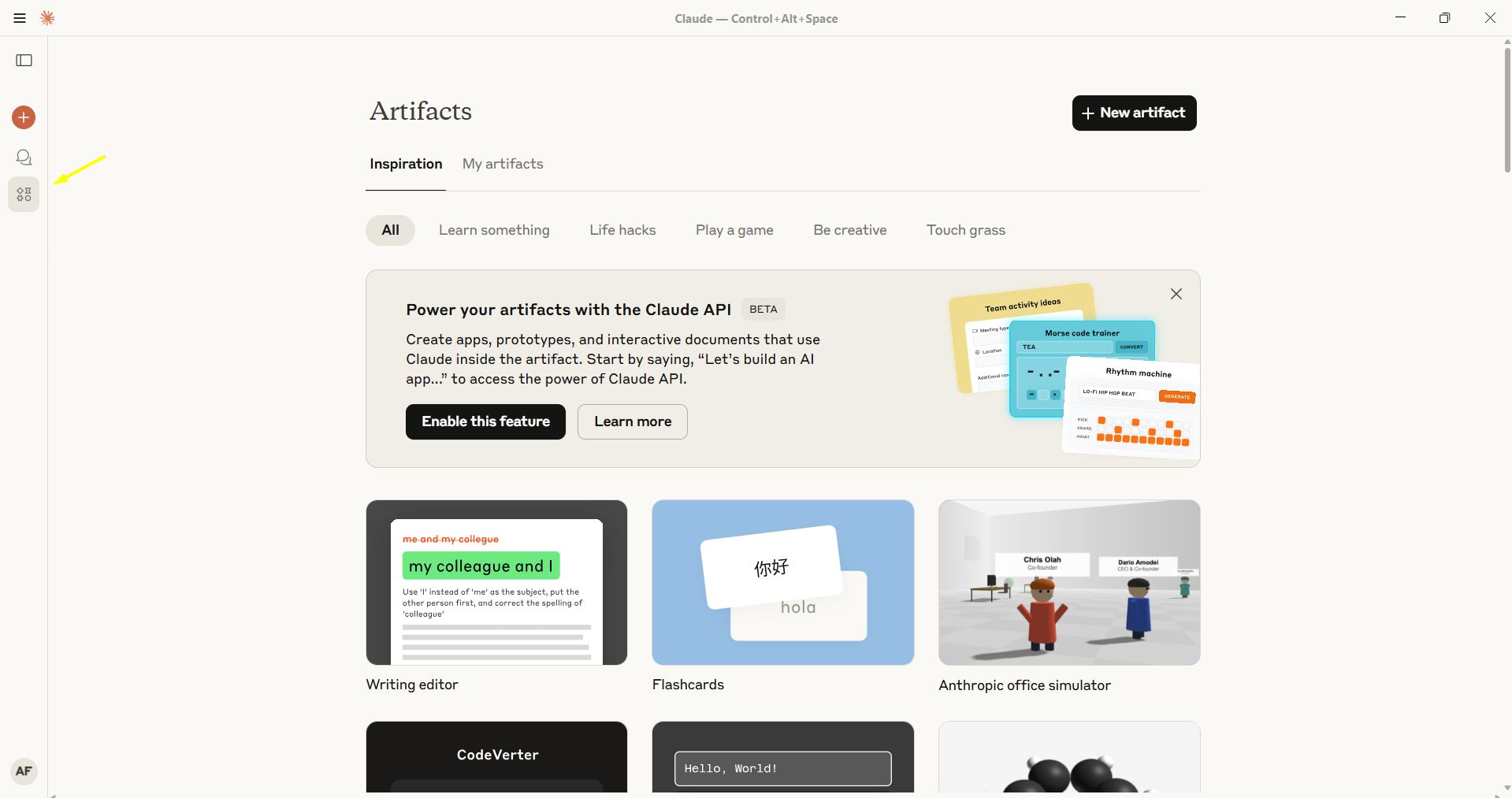
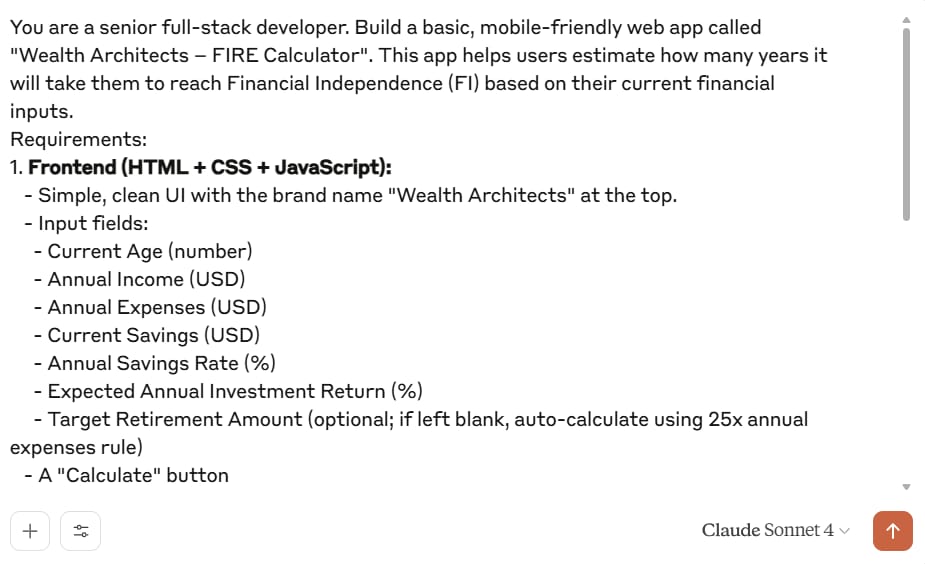
Click the "Generate" or "Build" button.
Within 2-3 minutes, Claude will analyze the request, write the code, and display your app in a live preview window.
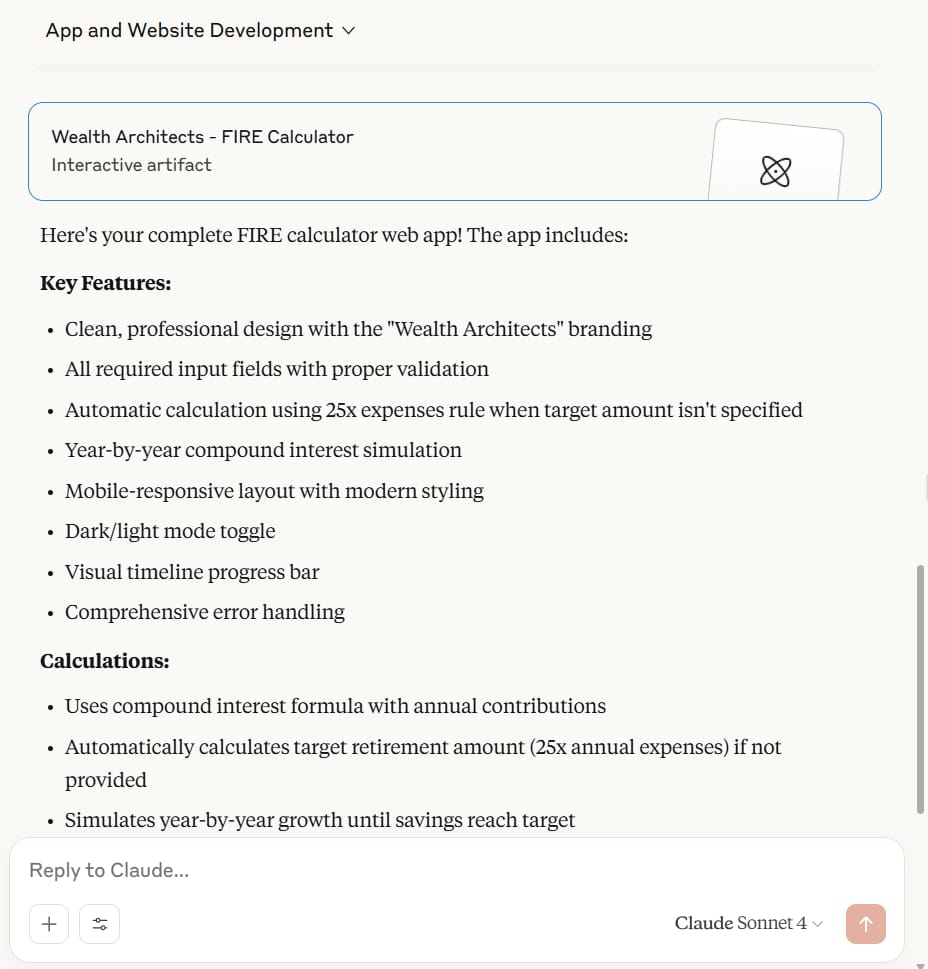
What Will The "FIRE Calculator" App Include?

The finished app, even as a basic version, will have impressive features:
Professional Interface: Your "Wealth Architects" logo and brand name.
Intuitive Input Fields:
Current Age.
Annual Income.
Monthly Savings Rate (%).
Current Savings/Investments.
Expected Annual Investment Return (%).
Desired Annual Spending in Retirement.
Personalized Results:
Displays the age at which the user can retire.
A visual chart illustrating wealth accumulation over time.
A prompt asking for an email to receive a detailed analysis and tips to reach the goal faster.
You can interact with the app immediately, trying different scenarios to see how smoothly it works.
Step 4: Publishing And Distributing Your App
One of the most powerful features of Claude Artifacts is the instant sharing capability.
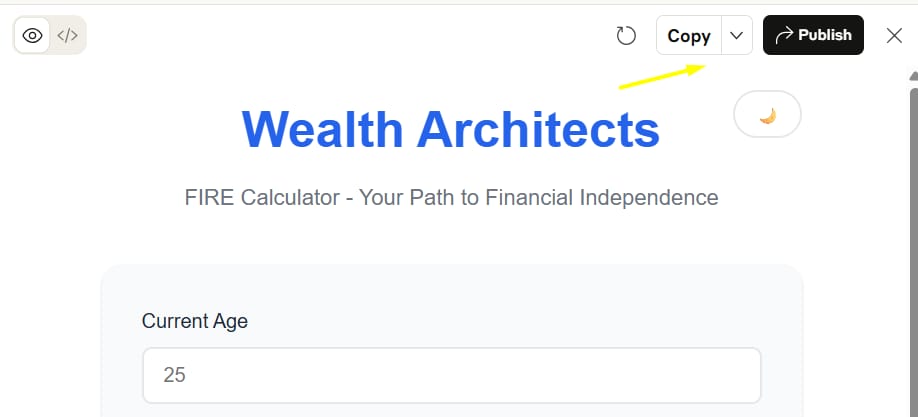
In the Artifact window, click the "Publish" or "Share" button.
Copy the unique link that is generated.
This link is now ready to be shared everywhere.
Where To Deploy Your Lead Magnet?

Website Integration: Add a prominent "Calculate Your Retirement Age" button on your homepage.
Email Signature: Include the link in your email signature.
Social Media Posts: Share it directly on LinkedIn, Facebook, and X with a compelling call-to-action.
QR Codes: Generate a QR code that links to the app and place it on business cards or marketing materials.
Blog Content: Write a blog post on "Early Retirement Planning" and embed your app as an interactive tool.
Paid Ad Campaigns: Use the link as the landing page for ad campaigns targeting your ideal audience.
The beauty of this approach is that you can test its effectiveness with real data before investing further. Let it run for a week, see how many people use it, and track how many emails you collect.
Step 5: Repeating The Process (Building A Second App)
To demonstrate how easily this process can be replicated, let's quickly build the second app: the Financial Health Scorecard.
Why A Financial Health Scorecard Is Effective
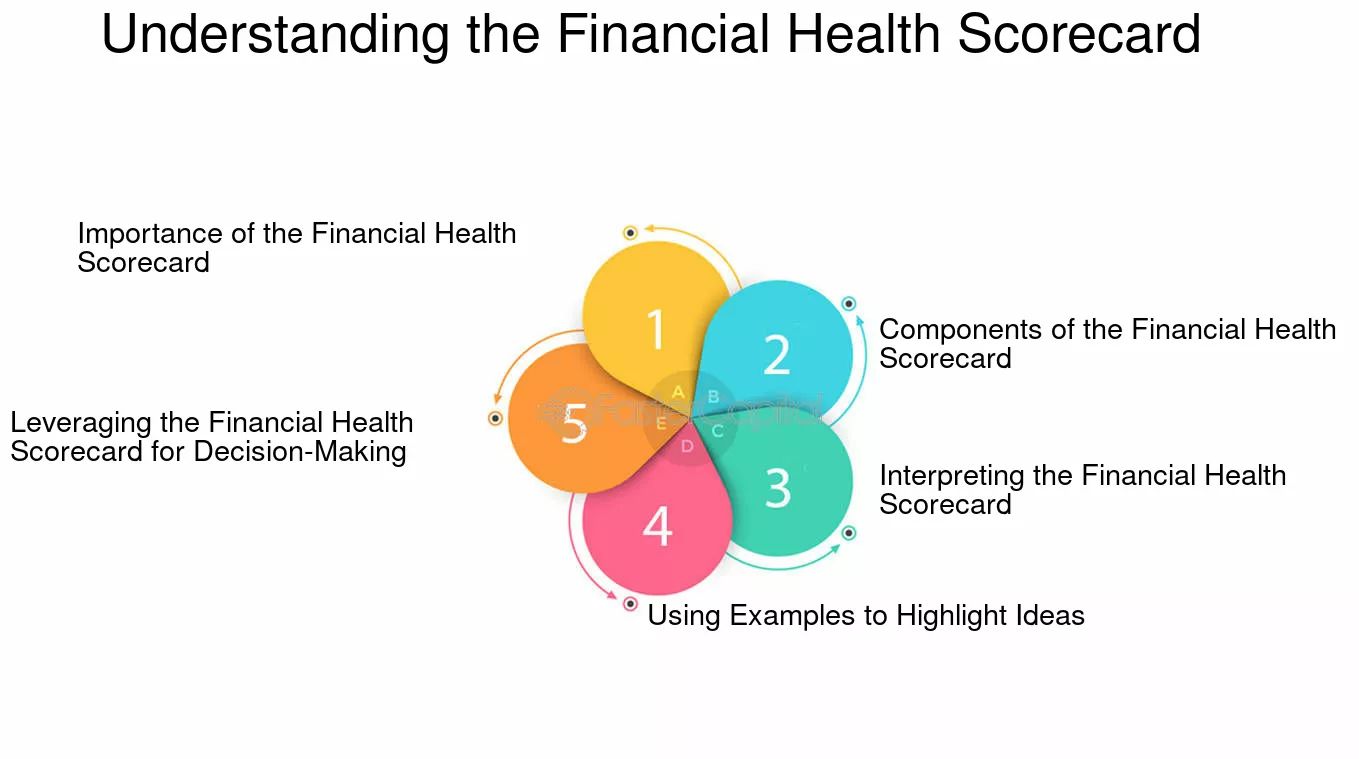
This tool addresses a fundamental but critical question: "Is my financial situation good or bad?" It provides a simple, understandable overview and serves as the perfect starting point for a consultative conversation.
The Build Process
Go back to ChatGPT and ask for a "one-shot build prompt" for the "Financial Health Scorecard." This time, ask it to include scoring categories and a grading system (e.g., from A to F).
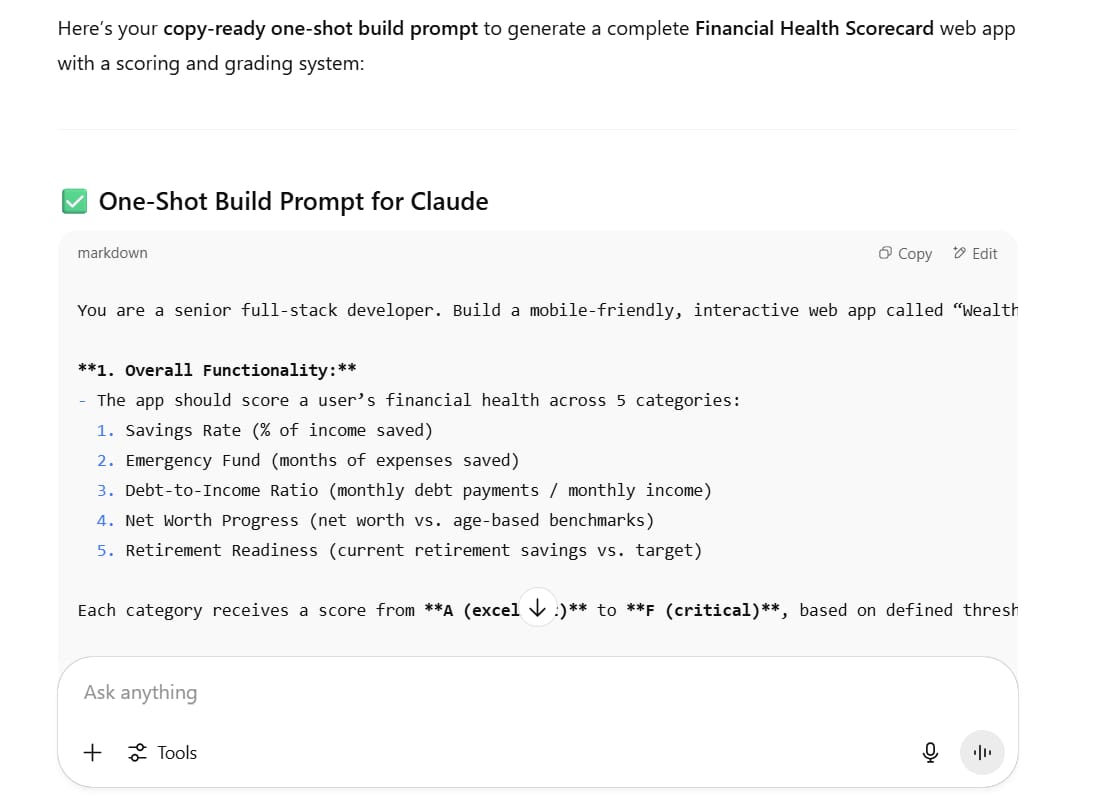
Copy the new prompt.
Open a new Artifact in Claude.

Paste the prompt and initiate the build process.
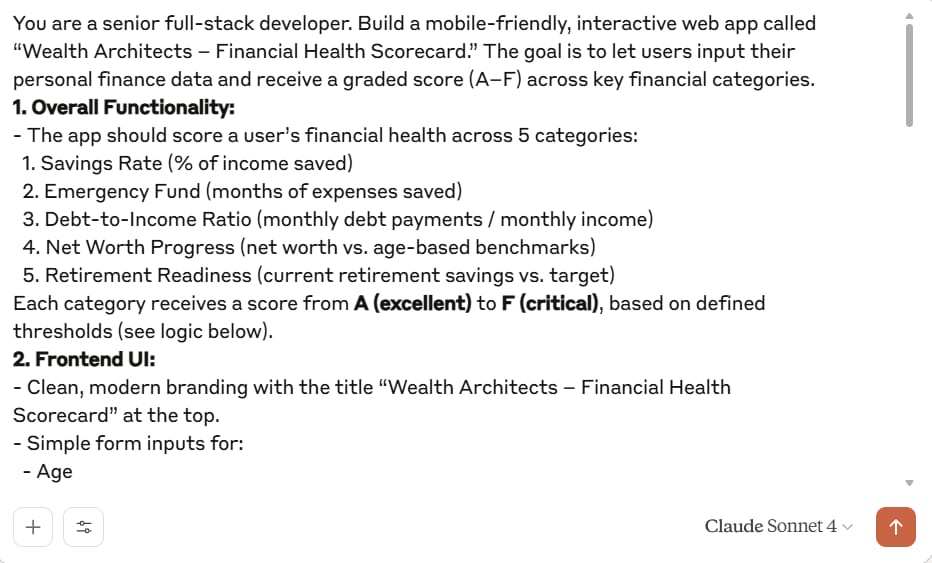
Features Of The Financial Health Scorecard
The finished app will include:
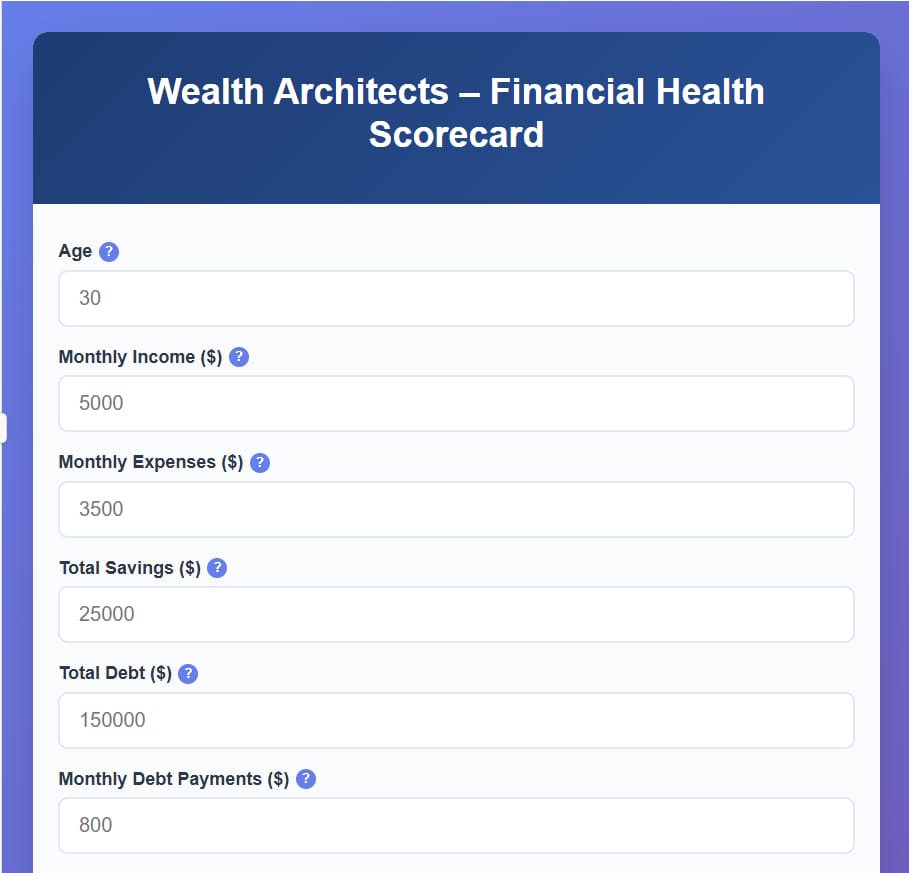
Quiz-style Questions: A series of questions covering different areas:
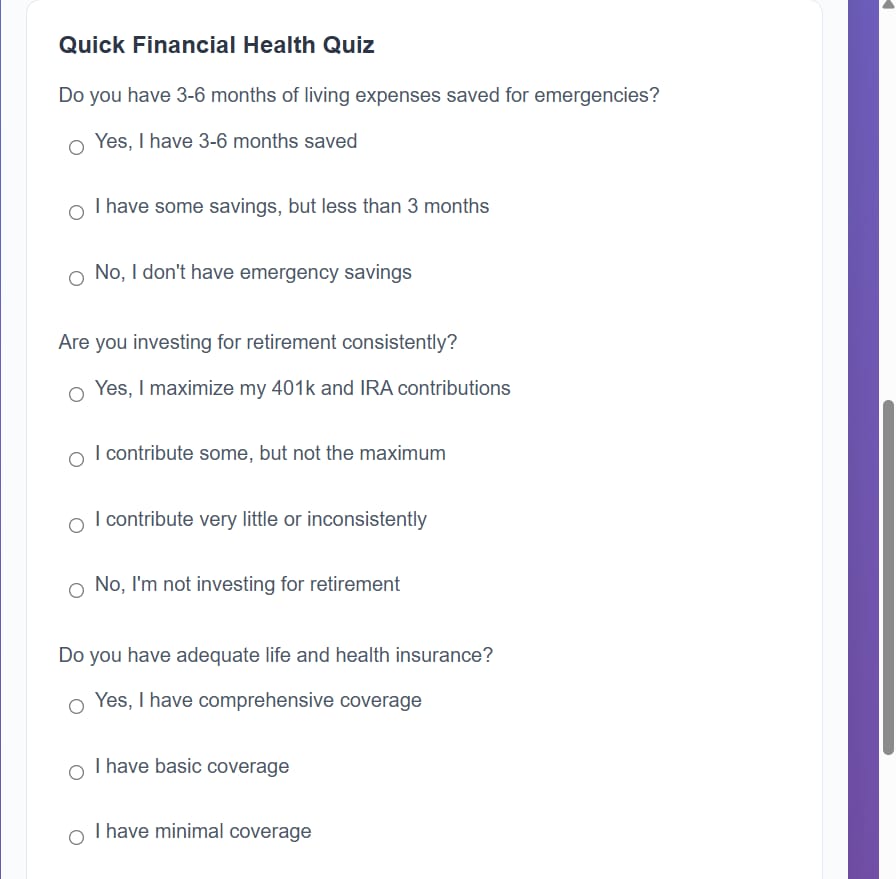
Emergency Fund: (Do you have 3-6 months of living expenses saved?)
Debt Management: (What is your debt-to-income ratio?)
Savings Rate: (What percentage of your income are you saving?)
Investing: (Are you investing for retirement?)
Insurance: (Do you have adequate life and health insurance?)
Scoring System: Based on the answers, the app will calculate and display an overall score (e.g., 75/100) and a grade (e.g., "B - Pretty Good").
Detailed Analysis and Recommendations:
Highlights strengths and weaknesses.
Provides specific, actionable recommendations (e.g., "Your next goal: Build a 3-month emergency fund.").
Asks for an email to receive a personalized 30-day action plan.
In less than an hour, you have created two powerful marketing tools, ready to work 24/7 to attract clients for you.
Step 6: Nurturing And Converting Leads
Creating a great tool is only half the battle. True success lies in how you handle the leads you collect.
Email Collection Strategy

Always ask users for their email in exchange for the most valuable part of the tool:
In the "FIRE Calculator," ask for an email to send a "Detailed Roadmap to Retire 5 Years Sooner."
In the "Financial Health Scorecard," ask for an email to send a "30-Day Action Plan to Improve Your Financial Score."
The added value you offer must be compelling enough for users to willingly exchange their contact information.
Building An Automated Email Sequence
This is where you connect your app to a Customer Relationship Management (CRM) system like HubSpot.
A lead nurturing email sequence might look like this:
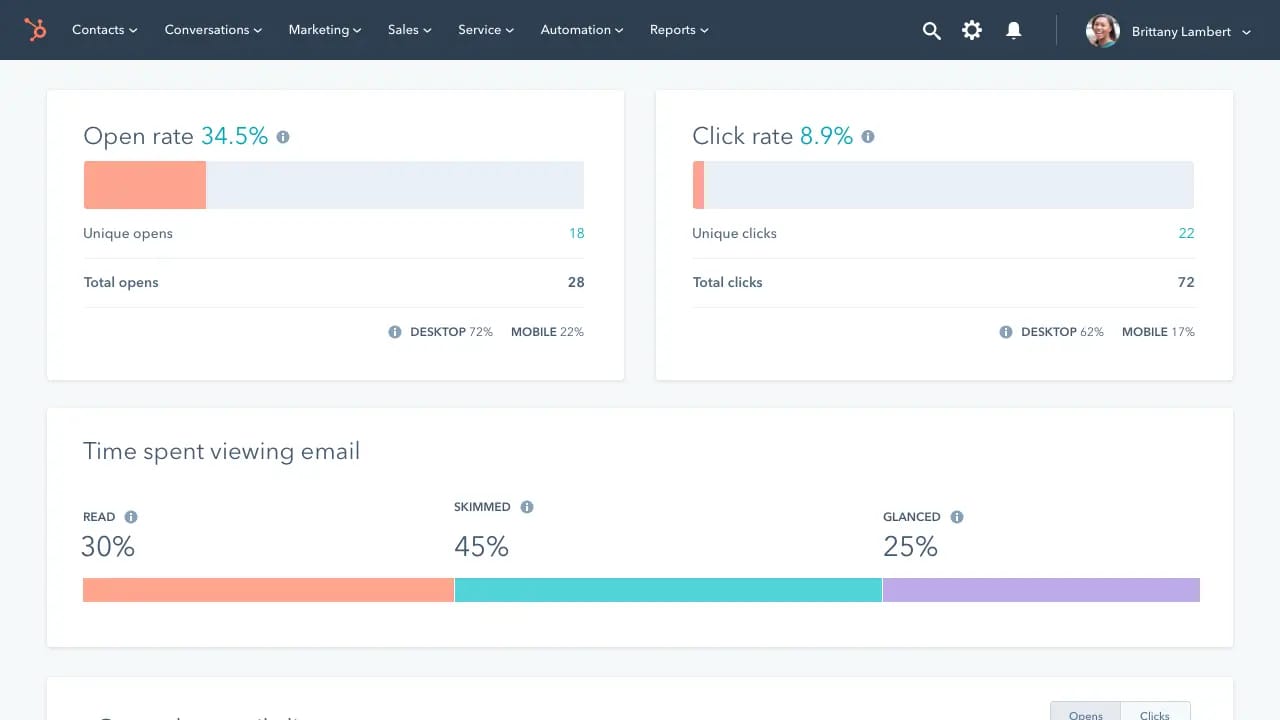
Email 1 (Immediate): Send the promised analysis/action plan. Thank them for using the tool.
Email 2 (2 Days Later): A blog post or short video that dives deeper into one aspect the tool mentioned (e.g., "3 Simple Ways to Cut Costs Without Affecting Your Lifestyle").
Email 3 (4 Days Later): Share a customer success story (case study). E.g., "How My Client Increased Their Savings Rate by 20% in 6 Months."
Email 4 (7 Days Later): An invitation to a free webinar on "The 5 Biggest Financial Mistakes Young Professionals Make."
Email 5 (10 Days Later): A direct offer: "Are you ready for a comprehensive financial plan? Let's book a free 30-minute consultation."
This system builds trust, establishes your expertise, and naturally guides the customer toward a purchasing decision.
Advanced Tips For Optimized Results
Improve Your App Based On Data

Collect Feedback: Add a simple question at the end of the app: "Was this tool helpful? What other features would you like to see?"
Use Heatmaps: Tools like Hotjar can show you where users click and scroll, helping you optimize the user interface.
Add More Complex Features: Once you've validated the idea, consider adding features like API integrations (to pull real-time stock market data) or user profile saving.
Ensure Accuracy And Transparency

Data Sources: For financial tools, use standard formulas and reasonable assumptions (e.g., average inflation rates, historical market returns).
Disclaimer: Always include a clear disclaimer that the tool is for informational purposes only and does not constitute official financial advice.
Measuring Success And Return On Investment (ROI)
Key Performance Indicators (KPIs) To Track
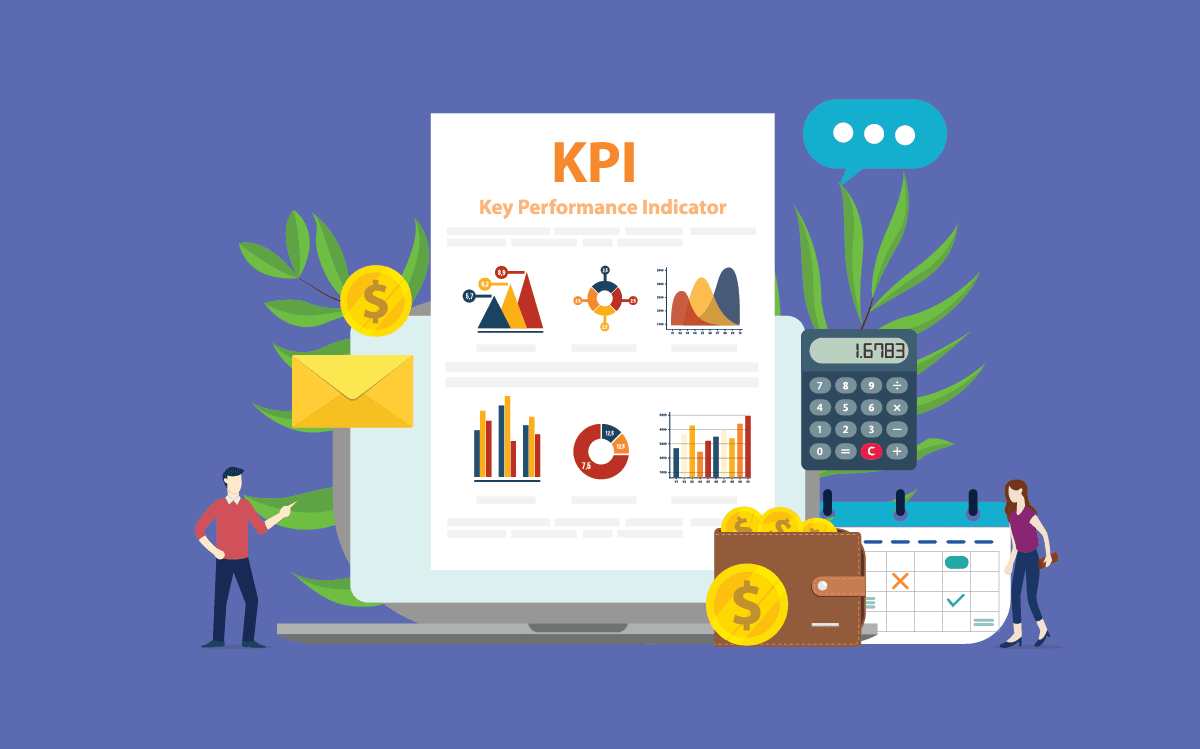
App Traffic: How many people visit your tool.
Usage Rate: The percentage of visitors who actually complete the tool.
Email Capture Rate: The percentage of users who provide their email. This is the most critical metric for a lead magnet.
Lead-to-Customer Conversion Rate: The percentage of collected emails that turn into consultations or paying clients.
When To Invest In A Full Version?
Consider upgrading from a Claude Artifact to a custom-hosted application when:
Your tool is generating over 100 high-quality leads per month.
You want to integrate more deeply with other business systems (CRM, accounting software).
You need full control over branding, user experience, and data security.
Common Mistakes To Avoid
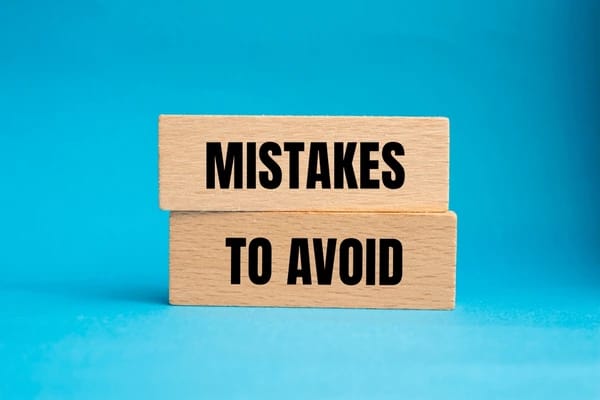
Overly Complicated: Your first version should focus on solving ONE problem exceptionally well. Don't try to add too many features.
Skipping the Testing Phase: Ask friends, colleagues, or a few trusted clients to try it out before you promote it widely.
Poor User Interface: Ensure your app is easy to use, especially on mobile devices.
Forgetting the Call-to-Action (CTA): After providing value, tell users exactly what you want them to do next (e.g., "Enter your email to get the plan," "Book a consultation").
Neglecting Follow-Up: Collecting emails without a nurturing plan in place is a waste of effort.
Conclusion: The Future Of Lead Generation Is In Your Hands
We are at a watershed moment in marketing and business. Creating effective digital tools is no longer the exclusive privilege of large corporations with huge budgets. With AI tools like ChatGPT and Claude, anyone with a good business idea can create professional lead magnets in minutes.
The process is simple and powerful:
Brainstorm customer-problem-solving ideas with ChatGPT.
Detail the idea into a blueprint (prompt).
Build the app instantly using Claude Artifacts.
Collect leads by offering additional value.
Nurture and convert leads into real customers with an automated system.
Start with simple versions to test your ideas, then iterate and improve based on real data. The key to success is focusing on solving the real problems that your potential customers face every day.
The tools are available now, they are incredibly powerful, and they are getting better every day. The question is no longer whether you can build effective lead magnets with AI, but whether you will seize this opportunity and start building them for your business today.
What lead magnet will you create first for your business?
If you are interested in other topics and how AI is transforming different aspects of our lives or even in making money using AI with more detailed, step-by-step guidance, you can find our other articles here:
How useful was this AI tool article for you? 💻Let us know how this article on AI tools helped with your work or learning. Your feedback helps us improve! |
Reply